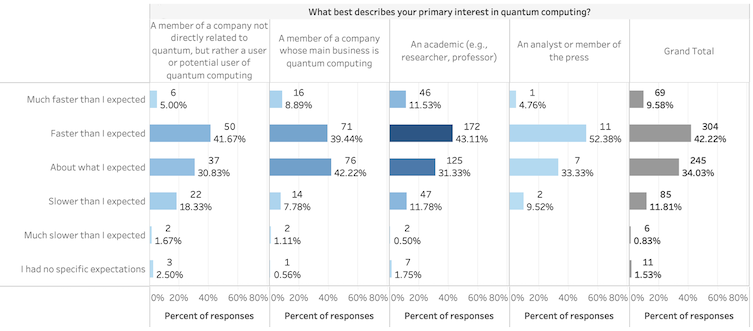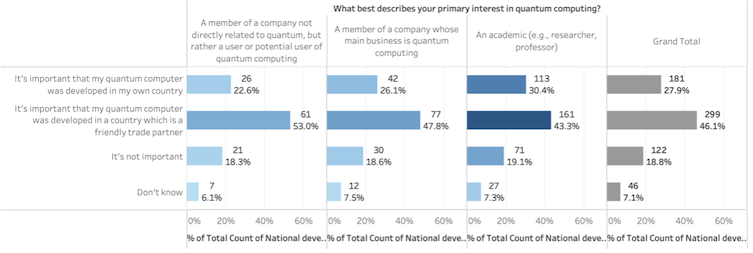As quantum computing advances rapidly, understanding the diverse perspectives of the key stakeholders in this field — manufacturers, end-users, and academia — becomes increasingly important. Each of these groups plays a crucial role in driving the development and deployment of quantum technologies, yet their priorities and concerns often diverge. Recognizing the different priorities is important to each of these groups by itself (for instance, manufacturers want to know what their eventual customers care about) but also for government bodies that want to align their research grant investments with the topics deemed important to these various constituents.
This article explores these differences, drawing on data from a June 2024 survey that asked nearly 1000 members of the quantum community to reflect on the current and future state of quantum computing. The survey explored multiple aspects of the quantum field: perceived progress, desired areas of investments, deployment configurations, national interests and more. Here, I will first present a high-level summary of each group’s views, followed by a deeper dive into the differences between them.
3 Groups in the Quantum Computing Development Space
We can broadly divide the quantum computing ecosystem into three subgroups. These groups vary in their priorities for the field as a whole.
- Manufacturers are focused on scalability and environmental sustainability.
- End-users prioritize error correction and access.
- Academia is dedicated to advancing fundamental technology.
What Do People Want From Quantum Development?
So, what does each of the major groups in the quantum playing field want out of the technology’s development?
End-Users
End-users prioritize error correction and fault tolerance over scalability, emphasizing the need for reliable quantum computers for real-world applications like cryptography and simulations. They prefer quantum computers developed by friendly trade partners, allowing access to technology without heavy investment. Many users believe the development pace is faster than expected and emphasize the importance of quantum cryptography and security due to increasing digital security needs.
Manufacturers
Manufacturers focus on scalability over error correction, emphasizing the need to build quantum computers that can handle more qubits without losing coherence. They are divided on where to develop quantum infrastructure, balancing in-country development and acquiring from trade partners, influenced by geopolitical and economic factors. Manufacturers generally view the pace of development as steady, aligning with their expectations as a result of the scientific and production challenges that still need resolution.
Academia
Academics prioritize investment in hardware development to advance research capabilities and explore new quantum phenomena. They prefer developing quantum computers domestically to maintain control over intellectual property and secure data. Opinions on the pace of quantum computing development are divided, with nearly half believing progress is faster than expected, reflecting their engagement with cutting-edge advancements and eagerness for rapid results in the field.
The three groups differ in their focus: end-users prioritize reliability and security, manufacturers emphasize scalability, and academics concentrate on hardware development for research. To address this disparity, fostering collaborations between these groups can align their goals, promote shared research and development, and facilitate the exchange of knowledge and resources. This alignment will ensure that advancements in quantum computing benefit all stakeholders.
Solving Technical Challenges
Identifying and overcoming the most pressing technical challenges is perhaps the most significant question for the quantum computing community today. Even getting the various stakeholders to agree on those challenges may be an issue, however.
According to our survey, scalability and error correction emerged as critical concerns for both manufacturers and end-users. For quantum computers to deliver true business value, they will need to scale to a larger number of qubits, which will allow executing more sophisticated algorithms. Qubits are fragile, however. Without quantum error correction algorithms, these larger algorithms will return meaningless results because the data will be corrupted. The emphasis each group places on these issues varies, however.
Manufacturers, who are deeply involved in building the hardware, are primarily focused on scalability (35.6 percent) as they work to increase the number of qubits their machines can handle effectively. For them, the challenge lies in building quantum computers that can scale up without losing coherence, which is a fundamental requirement for future quantum systems. For manufacturers, error correction comes in second at 30.6 percent.
End-users, on the other hand, prioritize error correction and fault tolerance (34.2 percent) over scalability (25 percent). Their primary concern is ensuring that quantum computers can operate reliably and produce accurate results in real-world applications. After all, end-users care are not interested in quantum purely for scientific reasons: They’re hoping to solve problems that are classically intractable.
This divergence in priorities highlights the different stakes each group has in overcoming these technical hurdles. Manufacturers believe that scalable systems will allow running the algorithms that end-users crave, while end-users care less about scalability unless it is accompanied by reliable and error-free operations.
This example highlights the different priorities each group has in overcoming these technical hurdles. A possible solution is for manufacturers to closely interact with end-users, understand the key applications they wish to execute, and perform tight co-design processes that show continuous progress but also manage schedule expectations in a realistic way.
Is Quantum Developing Fast Enough?
Considering these technical challenges, we should also evaluate how different stakeholders perceive the pace at which the community is making progress on solving them. This is important so that investors, governments and end-users can set realistic expectations as to when quantum computing will start fulfilling its potential. For instance, if businesses believe that quantum utility is two years away, they might want to start investing immediately. If quantum utility is five years away, however, perhaps some businesses can wait.

When it comes to the pace of quantum computing development, academia and the commercial sector have widely differing views. Manufacturers tend to take a more conservative view, with a significant portion (42.2 percent) believing that the pace of development is as they expect. This cautious optimism likely stems from their understanding of the fundamental scientific challenges and production restrictions that the community still needs to addressed.
In contrast, researchers and end-users are more divided. About 47.9 percent of researchers and 46.7 percent of end-users believe that the pace is faster or much faster than anticipated, reflecting the recent advancements in research and the deployment of quantum technology. These stakeholders, driven by their exposure to cutting-edge developments, are eager to see faster results and broader adoption of quantum computing.
The difference in expectations underscores the varying timelines that each group operates on. Manufacturers, who focus on creating value through reliable and scalable technology, are more attuned to the gradual nature of technological breakthroughs. Meanwhile, researchers and end-users, who are keen to apply quantum technology in practical scenarios, often push for quicker progress. End-users would do well to develop a realistic view of the timelines despite the occasional hype. Just like AI, quantum computing is a marathon, not a sprint, until it reaches an inflection point in usefulness.
Where Should We Build Quantum Computers?
Another area of divergence is the preferred location for quantum computing infrastructure. Academics are more inclined toward developing quantum computers within their own countries, with 30.4 percent favoring this approach. This preference is perhaps driven by funding. If more development is done in-country, more funding will likely be available for local researchers.

End-users, however, are content having quantum computers developed by a friendly trade partner (53 percent). This approach offers flexibility and access to quantum resources without the need for significant upfront investment in hardware. Additionally, it allows countries that may lack the infrastructure to produce high-quality, fault-tolerant quantum computers to still benefit from these advanced technologies.
Manufacturers are split between the two preferences, with 26.1 percent supporting in-country development and 47.8 percent leaning towards acquiring quantum computers from trade partners. This variation in preferences may be influenced by the diverse national backgrounds of the respondents, highlighting the impact of geopolitical and economic factors on the decision-making process. Several countries have made substantial investments in local manufacturers, so a manufacturer receiving these subsidies is likely happy with in-country development. On the other hand, manufacturers are keen to sell their products across borders, and policies that favor in-country acquisitions can significantly reduce their available market, especially for manufacturers that come from markets with smaller economies.
The difference in preference between end-users and academia suggests that, although academic institutions prioritize control and innovation, end-users are more concerned with practical access and cost-effectiveness. Manufacturers are torn between the desire of their governments to protect them against outside vendors, and the need to sell product outside their native country. This disparity may have significant implications for where and how quantum computing infrastructure develops globally. If strong in-country preferences exist, manufacturers might need to relocate to those countries. Alternatively, if governments adopt more of a free-trade approach with national security oversight, they allow the global market to flourish, perhaps to everyone’s ultimate benefit,
Investment Priorities for Quantum Development
Investment priorities in quantum technology also differ significantly among the segments. Academia clearly prioritizes hardware development, viewing it as an area that should receive significant investment. This focus is likely driven by the need for advanced research tools that push the boundaries of quantum science.

End-users and manufacturers tend to follow a similar trend. End-users place a much higher importance on cryptography and security. This emphasis reflects the growing need for robust security measures in today’s digital age, where quantum computing is expected to play a critical role in protecting sensitive information.
These differences highlight how each segment approaches quantum technology based on their immediate needs and long-term goals. Academia’s focus on foundational research contrasts with the practical concerns of end-users, who prioritize security and application-ready systems.
What Should Quantum Development Look Like?
As quantum computing continues to develop, it is clear that different stakeholders have varying priorities and concerns. Manufacturers are focused on scalability and environmental sustainability, end-users prioritize error correction and access, and academia is dedicated to advancing fundamental technology. Understanding these differences is crucial for fostering collaboration and ensuring that quantum computing advances in a way that benefits all sectors.
By acknowledging and addressing the unique perspectives of each segment, the quantum computing community can work together to overcome challenges and harness the full potential of this revolutionary technology. Moving forward, cross-sector dialogues and collaborative initiatives will be key to aligning these diverse priorities and driving the field forward.





